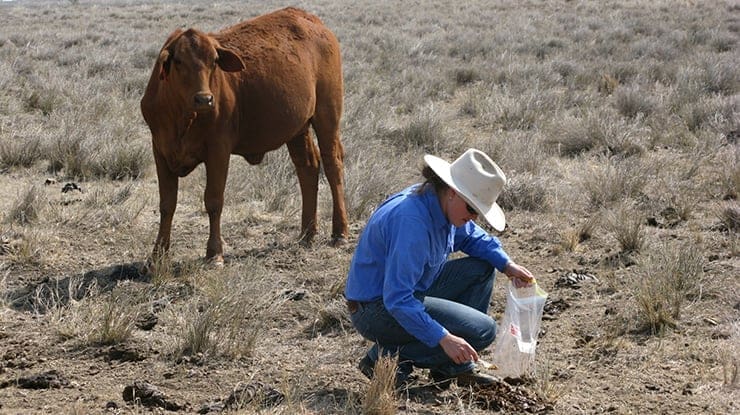
USING Near Infra-red Reflectance Spectroscopy (NIRS) to analyse dung towards the end of the pasture growing season provides a quick, cheap and reliable prediction of your herd’s diet quality.
Dung sampling can be a useful decision-making tool in northern cattle production systems, MLA beef productivity manager Lindsey Perry said.
“Faecal NIRS analysis of dung samples for cattle grazing tropical northern pastures indicate the nutritional status of a herd. Results can be used to make more informed grazing management and nutrition decisions,” Dr Perry said.
What to look for
The key outcomes of the analysis include predicted estimates of dietary crude protein (CP), dry matter digestibility (DMD) and the non-grass proportion of diet.
The DMD value is expressed as a percentage and indicates how much of what the animal grazes in the paddock is digested in the gastrointestinal tract.
Good quality, digestible pastures that support production should be above 55pc in tropical grasses. As digestibility declines towards 50pc or below energy will be limiting and animals will be maintaining or losing weight.
“The percentage of non-grass in the sample tells you that cattle are consuming legumes, forbs, or temperate grasses,” Dr Perry said.
Another prediction included is ‘Ash’, which estimates how much soil has ended up in the dung sample. This could be from poor sampling technique or may indicate that feed quantity is too low and cattle are grazing close to the ground.
“It’s important to consider the values against what’s happening in the paddock,” she said.
“Is the quality good, but the quantity of feed limiting? Is the quality declining but cattle are in very good condition? Balance the results against other data and observations to make informed decisions.”
Local beef advisors or private consultants can provide useful support to interpret faecal NIRS results appropriately.
Planning for your season
Testing can be done at any time, but during the pasture growing season, results will change quickly. Dung sampling done from the end of the growing season and during the dry season is ideal.
“Identifying the quality of your herd’s diet helps to determine when stock are likely to require supplements, when weaners should come off and when cattle are likely to lose condition.
“This way, producers can make strategic management decisions,” Dr Perry said.
“We encourage all producers to be proactive in their herd planning and faecal NIRS analysis is one tool to support productive overall herd management.”
NIRS testing services are provided by Symbio Laboratories, Brisbane and Gilmac, Perth.
Further reading: Dry season decisions: When to supplement? FutureBeef
Source: MLA

F.NIRS diet quality testing provides an indication of the average diet quality for a herd over a 5-day period. Digestibility is strongly positively correlated with energy. On tropical grass pastures, once pasture begins drying out, digestibility levels are rarely as high as 55%. This is the level required for heavily pregnant breeders and wet cows to meet their energy requirement, provided there is sufficient pasture available for the breeders to meet their daily dry matter intake requirement.
The non-grass can include C3 plants that are nutritious such as legumes, forbs (herbage) and temperate grasses, however, they can also include native browse (i.e., leaves on the trees) which are low in nutritional value, and generally contain high tannin levels which bind up much of the protein. It is important not to take the results on face value, particularly where there is native browse in the diet, and requires significant technical understanding of the technology and the land systems where samples are taken, to correctly interpret results.
A high ash can also be caused by samples taken from cowpats where there has been dung beetle activity. Minimizing soil contamination is vital because it causes an overprediction of dietary crude protein and digestibility levels.
Diet quality testing provides good information on the degree of deficiencies of protein and energy in the diet as well as the likelihood of when animals responding to nitrogen supplements (eg. urea), and hence, determining when to put out urea-based dry licks and other nitrogen supplements, and when energy becomes more limiting in the diet.
Diet quality testing does not take into the availability of feed which is an important driver of animal production.